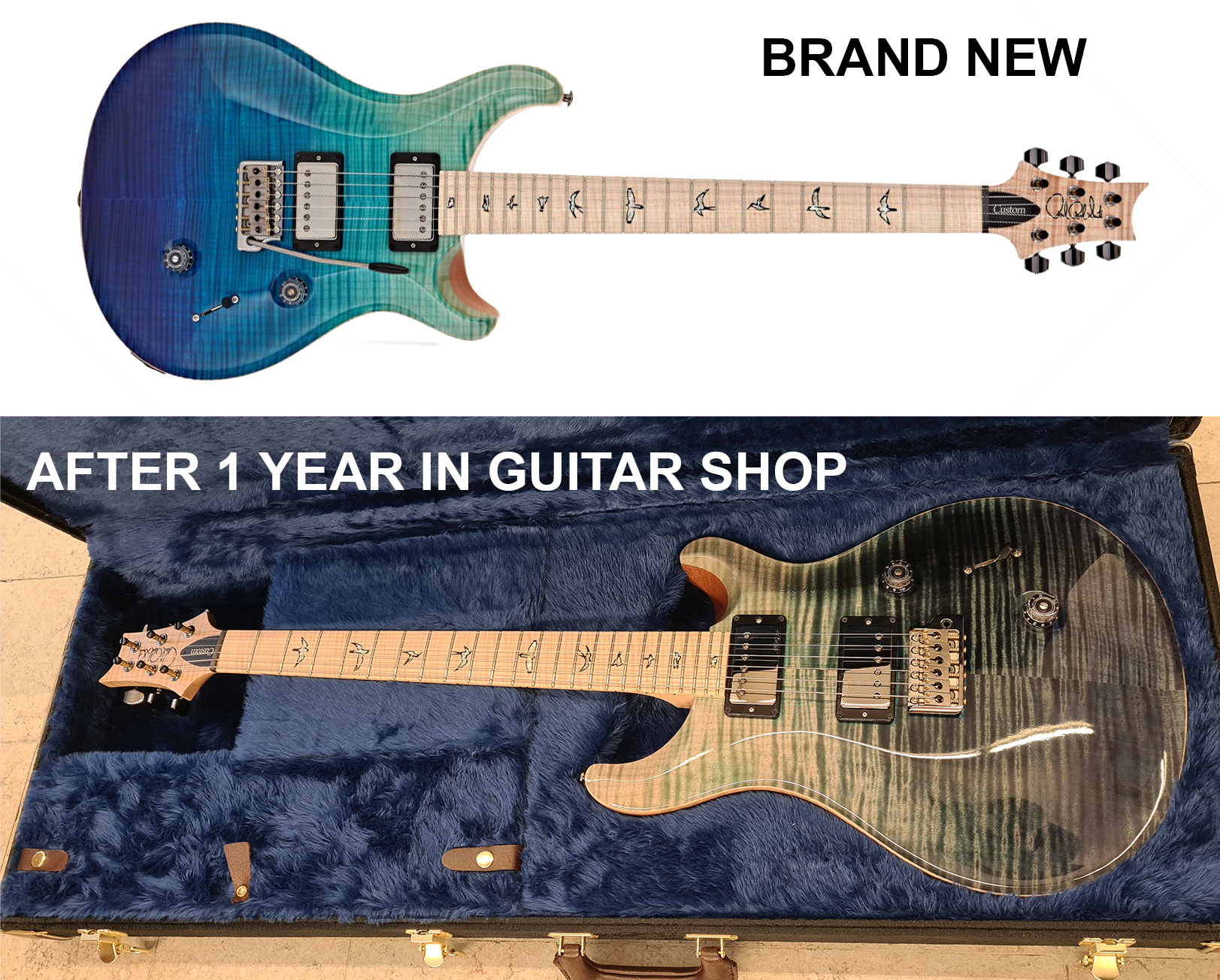Easy fix:i really wish i could get my whale blue Cu22 to fade. sigh
Gila Bend, AZ. My first winter without snow. 133 with no wind.
Easy fix:i really wish i could get my whale blue Cu22 to fade. sigh
i lived in PHX for 2 years. 118 the day i got off the plane. not a fanEasy fix:
Gila Bend, AZ. My first winter without snow. 133 with no wind.
Playing catch-up here, thanks so much for laying this out! This is really good info!As I understand it, fading of organic dyes is a chemical reaction, like photosynthesis, or cooking food. Can't be undone, and I'd imagine, isn't easy to prevent. I honestly don't know how much sunlight is necessary to trigger a noticeable chemical reaction in the dyes that are in the stains PRS uses. I'd guess it's more than an afternoon playing, but then I've gotten suntanned in a day, and that's a chemical process just like dyes fading. So, anyone's guess.
It's been mentioned that there are UV-resistant car finishes. The UV-resistant clear coats on cars are designed to prevent photo-oxidation, in other words, dulling of the paint. Oxidation is a different process than photosynthesis; think rust. Whether these finishes would prevent the chemical reactions that cause fading, I don't know.
As far as I know, UV finishes are poly and/or ceramic finishes. I have absolutely no idea whether they have an effect on the tone of the instruments, so I'm not making any claims that they do. Maybe so, maybe not. Finishes with UV protection require at least 2 mils of thickness, or they don't work at all, and cars usually have around 5 mils, according to what I've read (I claim no expertise on this stuff, I just read a lot).
What I can do is explain why the stains tend to fade, but paints don't:
Paints and inorganic stains are made with pigment. Pigment consists of finely crushed minerals. It needs a solvent to further refine the tiny crystals, and it needs a binder (usually oil based). As a result of the binder, the stain sits on top of surface of the wood, hiding the grain. It isn't absorbed well by the wood cells.
There is no getting around this, it's the nature of the beast.
Minerals (as opposed to organic materials) are used to create things like metals, fired clay, etc. This is why you cook with a metal frying pan, or eat from fired clay dishware - minerals tend not to get involved in the chemical reaction of making food. This is why you don't use organic materials, like wood, to make frying pans.
This is also why the metallic blue on the painted guitars in one of the pics above isn't going to noticeably fade much. If there's a chemical reaction in the crushed minerals used in the paint causing fading, it's going to be pretty minimal. They're more likely to dull in the sun from oxidation breaking down the paint, than fade the way organic dyes tend to.
Dyes are made with organic materials and chemicals that animals and plants make. This is where the photosensitivity comes in. This is different from dulling from oxidation, which is a different process.
Dyes are water-based, using organic materials that dissolve in water. Wood absorbs water-based dyes much better than minerals with oil based binders.
Therefore more of the wood grain shows through when a stain uses organic dyes. Thus you get the beautiful PRS finishes where the beauty of the wood shows through.
If you want to see wood grain you have to use water-based organic dyes in the stains. If there's a drawback, it's that organic stains are made with materials that when exposed to light, react with it chemically.
There's no getting around this with current stain technology. It's also the nature of the beast.
For me, the most important thing is a great sounding guitar. Based on personal experience with PRS' nitro finishes for the past 9 years, I prefer the nitro finishes to the many earlier PRSes I had with poly.
Obviously, they don't have UV protection. For me, that's a worthwhile trade-off. For others it might not be.
Blue dyes are made with stuff like indigo, a plant, sometimes with cabbage leaves, etc. The stuff reacts with light pretty strongly, because it's supposed to - it's a plant.
If I played outdoors, I probably wouldn't play one of my blue PRSes if I didn't want them to fade. Actually, I never planned to buy blue PRSes, it just kinda happened. I prefer other colors.
I hope this discussion helps decipher the mystery of the fading.
Oh sh1t… I’d be looking for a refund there mate..I have recently ordered a PRS Custom 24 Wood Library 10 Top, Blue Fade. Look how it has faded over 1 year in the store... Insane!!!
This should really not happen to such expensive guitars...

Wow! Never seen that much fade.Blue guitars never fade

